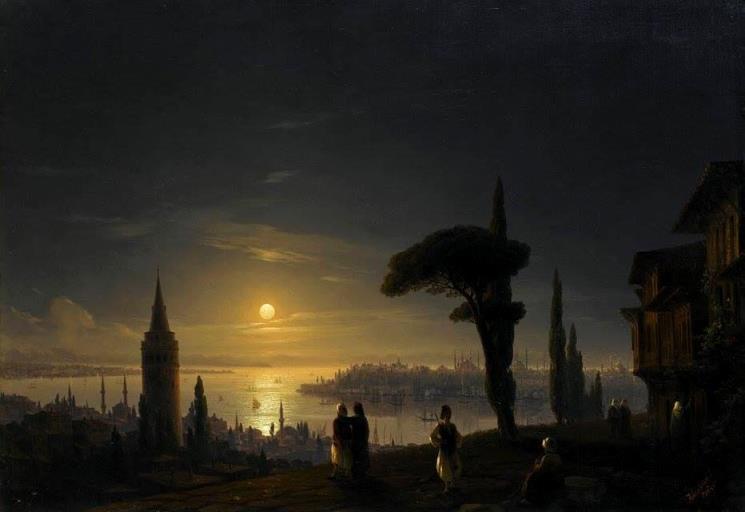Ivan-Konstantinovich -Aivazovsky's-Paintings
Artist Ivan Konstantinovich Aivazovsky - Художник Иван Айвазовский ( Ivan Aivazovsky ), 1817-1900, a Russian artist. Born in Feodosia on July 17 (29), 1817 in the family of an Armenian businessman. Studied at the St. Petersburg Academy of Arts under M.N. Vorobyov (1833-1839). He worked in the Crimea, Italy, also visited France, England and a number of other countries. He loved to travel, but from 1845 he worked mainly in his hometown. Particularly felt the impact of the French marina of classicism. Aivazovsky ultimately obtains true visual freedom by removing the excessively harsh contrasts of the classicist composition. The bravura-catastrophic "Ninth Wave" (1850, Russian Museum, St. Petersburg), which created the illusion of a "boundless" sea area, may be a product of its early phase.
Aivazovsky and his "Ninth Wave." What is the secret of Aivazovsky's Popularity? Today we will discuss not just the paintings of the great 19th century maritime painter, but also how his paintings were perceived by his contemporaries. Few Russians saw the water until the 1930s, when they began to go to seaside resorts. Previously, the sea was only known via Aivazovsky's paintings. At the time, the world was still engulfed in the atmosphere of romanticism, chanting the elements' praises. And, like other romanticist painters, Aivazovsky highlighted man as a part of nature, portraying its strength and unpredictability, creating in the viewer a sensation of tenseness.
At his childhood, he enrolled in St. Petersburg's Imperial Academy of Arts, where he studied marine landscape painting as well as battle marine painting. In Russia, he had almost no competition. Those who were often resided in other countries. Ordinary folks hardly seldom viewed their photographs. With his skill and workaholism, Aivazovsky had every possibility of becoming renowned. He rose to prominence as a well-known and well-liked artist. And "The Ninth Wave" is his crowning achievement. Aivazovsky enjoyed travelling a much. He travelled to Italy, France, Holland, the United Kingdom, Germany, and other European nations, as well as Egypt, Turkey, and America. The artist's international passport, which is housed in the Feodosia Picture Gallery. is a 46-page notebook and an attached sheet half a meter long. It contains 135 visas.
In 1850, the artist made his magnificent "Ninth Wave" at his workshop in Feodosia. All of the master's works were produced from memory, and he only produced little drawings in nature. He thought it was hard to depict natural occurrences because they were continuously changing: "The motions of living components are elusive for the brush." Despite its size (three by two metres), Aivazovsky completed "The Ninth Wave" in just 11 days. In general, he worked exceptionally rapidly and extensively: throughout the course of his life, he made almost 6,000 paintings. Dostoevsky compared the maritime painter to the prolific writer Alexander Dumas the older.
The dramatic narrative of the picture is classic of romanticism. The ship was destroyed in a storm, leaving just a part of the mast on which six seamen are attempting to live. The storm is still raging, and the most hazardous wave is bearing down on the unlucky. But the morning has already arrived, and the sun shines brightly, bringing hope for redemption. Colors that are bright yet not totally realistic are other characteristics of romanticism. "Aivazovsky definitely possesses the secret of drawing up paints...>, I have not seen such vivid and pure hues even on the shelves of mosque stores," painter Ivan Kramskoy wrote to gallery owner Pavel Tretyakov. The stores that sold household chemicals were known as "Moskitnye." "The Ninth Wave" marked the peak of Aivazovsky's romantic era. The 33-year-old artist was already well-known in Russia and abroad, having earned numerous gold prizes and been named an academician of the Imperial Academy of Arts. However, this painting quickly became a masterpiece. In terms of commercial success, the "Ninth Wave" could only be compared to Karl Bryullov's "Last Day of Pompeii," which heavily impacted Aivazovsky's work. People also waited in long queues to see the painting, sometimes many times. In the nineteenth century, the tale of the ninth shaft was highly popular. During a hurricane, the sailors felt that the ninth wave in a succession was the largest and most devastating. The painting's heroes, six unlucky seamen, met with her. They cling to life on a splinter of a sunken ship's mast amid a rough sea.
Aivazovsky's waves are incredible. The light of the sun shines through them. The artist produced the transparency effect by layering numerous strokes on top of each other (glaze). Such swells are uncommon. Please keep in mind that the waves are coming from the victim's side. And they're not all that big. Death waves can reach a height of 20-30 metres. They are no more than 3 m high on the "Ninth Shaft." Perhaps Aivazovsky spared his heroes to demonstrate their ability to cope. It would be a disaster if he wrote a 30 metre wave that went directly to people. He was also a believer. And he softens the sorrow in nearly every picture with shipwrecks. It gives us hope. In the shape of a rising sun. Those who had escaped landed. The visible ship. Everyone was impressed by Aivazovsky's realistic waves. When he looks at his works, artist Karl Bryullov says he tastes salt.
The most intriguing aspect is that the waves on the "Ninth shaft" are represented incorrectly! Wrapping wave crests, sometimes known as "aprons," never occur in the open sea. Only along the shore, when the waves are already crashing on the beach or rocks.
This is not to say that Aivazovsky was unaware of it. He was trapped in a severe storm in 1844. The press even reported that he had been assassinated. Then he remembered that many of the people were terrified. And he stood on the deck like a lunatic. He stared at the roaring water with all of his eyes. He soaked up impressions for future works.
Why did he misrepresent the waves?
Aivazovsky was a romantic by nature. That is, an artist who was enamoured with the natural world. He also stressed the power of nature via a variety of impacts. Yes, the foamed, twirling wave does appear to be more beautiful. It is easier to comprehend for the average individual. Than a genuine wave's imposing, pyramidal shaft.
Despite their tiny stature, the individuals on the Ninth Shaft are meticulously written. Their postures and movements are also highly expressive. They're in a dire situation. With every last ounce of strength, they battle for their lives.
Two of them are going to fall off the ledge. One has already slipped and fallen into the sea. The other clings to him with all his might. Perhaps we are seeing their last moments.
"O sea, have mercy on us!" said another sailor, reaching up his hand to the heavens. From behind, we notice another sailor. He holds a crimson cloth in his hand. The ship can't be seen. Furthermore, waves obscure the review. For what purpose? Apparently, it's for good fortune.
Please note that the folks are dressed in oriental attire. A ship from another country sunk. These persons are unknown to the audience. They aren't his own belongings. These aren't the shopkeepers from down the block. There's a reason why Aivazovsky adds so much space. It helps to alleviate acute anxiety. This would make it difficult to admire the roaring sea and people's bravery.
In the Painting "The Ninth Wave," the sky is upbeat. The sun rises, the clouds scatter, the sky brightens, and the darkness fades as a powerful breeze blows them away. Aivazovsky was a skilled artisan. But it was his lighting effects that he excelled at. He didn't use any special paint for this project. However, his sun shone so brightly that many people mistook him for someone else. Some even glanced behind the photo with sincerity. They mistook a candle for a candle beneath the canvas.
The first artist to hold solo exhibits was Aivazovsky. Not just in St. Petersburg, but also in the provinces. Aivazovsky has always wanted his art to be accessible to the general public. As a result, every store has postcards of his marinas, and every glass-room has copies of his paintings.
Aivazovsky was the first Russian artist whose work was chosen for a show at the Louvre in Paris. Aivazovsky's paintings quickly became the most important event in the creative life of the French city in the days after the exhibition's debut. Thousands of people flocked to see them. The master was given a gold medal by the council of the Paris Royal Academy of Arts as an outcome of the exhibition.




























































































No comments:
Post a Comment